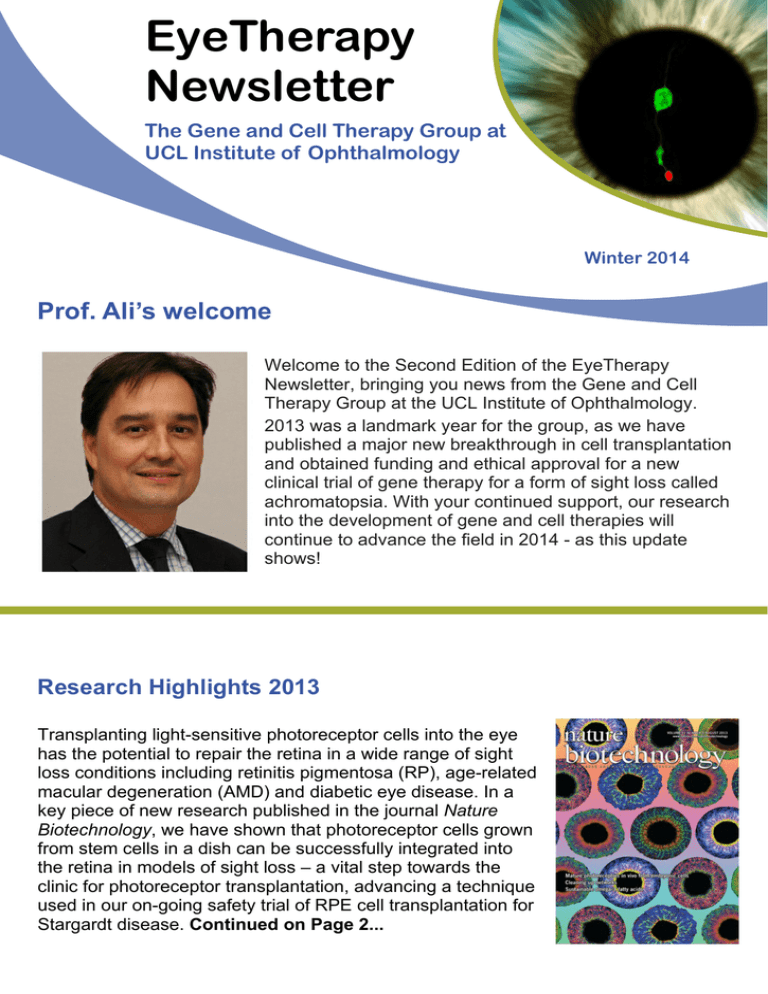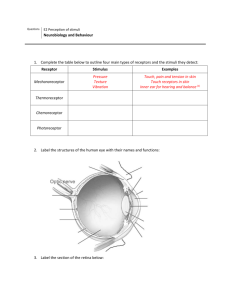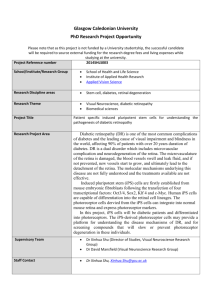EyeTherapy Newsletter Prof. Ali’s welcome The Gene and Cell Therapy Group at
advertisement

EyeTherapy Newsletter The Gene and Cell Therapy Group at UCL Institute of Ophthalmology Winter 2014 Prof. Ali’s welcome Welcome to the Second Edition of the EyeTherapy Newsletter, bringing you news from the Gene and Cell Therapy Group at the UCL Institute of Ophthalmology. 2013 was a landmark year for the group, as we have published a major new breakthrough in cell transplantation and obtained funding and ethical approval for a new clinical trial of gene therapy for a form of sight loss called achromatopsia. With your continued support, our research into the development of gene and cell therapies will continue to advance the field in 2014 - as this update shows! Research Highlights 2013 Transplanting light-sensitive photoreceptor cells into the eye has the potential to repair the retina in a wide range of sight loss conditions including retinitis pigmentosa (RP), age-related macular degeneration (AMD) and diabetic eye disease. In a key piece of new research published in the journal Nature Biotechnology, we have shown that photoreceptor cells grown from stem cells in a dish can be successfully integrated into the retina in models of sight loss – a vital step towards the clinic for photoreceptor transplantation, advancing a technique used in our on-going safety trial of RPE cell transplantation for Stargardt disease. Continued on Page 2... EyeTherapy Newsletter Research Highlights 2013 Transplanting photoreceptor cells from retina ‘grown in a dish’ (Continued from page 1…) Our previous proof-of-concept studies have shown that immature photoreceptor cells can integrate into the retina of recipient mice, and can restore vision in several different models of sight loss. In those studies we used retinal cells from newborn mice as the donor cells - to progress towards a clinical treatment, we need a source of donor cells that is renewable and easy to obtain – which is why in the current study, Dr Gonzalez-Cordero and colleagues from our group use stem cells to grow retinal cells in a dish to the equivalent stage in eye development, using these cells as a source for transplantation. A study we published last year showed that photoreceptor cells grown from stem cells in flat, 2-dimensional culture dishes have many of the characteristics of photoreceptors at the right stage of development for transplantation, but cannot successfully integrate into the eye when transplanted. Dr Gonzalez-Cordero’s new study builds on ground-breaking research from Japan that showed the efficient production of eye cells from mouse embryonic stem (ES) cells, when the stem cells are grown in a 3-dimensional culture system – allowing retinal cells to grow spontaneously. Using this 3D culture system, we produced photoreceptor cells that successfully integrated into three different models of sight loss, connected to the rest of the retina and expressed the protein machinery needed to sense light. Technical improvements should increase the number of transplanted cells integrating into the recipient retina, following which we can test if stem cell-derived photoreceptors can restore vision in models of sight loss. Demonstrating that stem cell-derived photoreceptor cells can successfully integrate into the degenerating retina is an important step forward towards a clinical trial using photoreceptor transplants to treat sight loss. Before such trials can begin, we need to show that cone photoreceptors, the cells we use to detect colour and in detailed central vision, can also be transplanted – the current study focussed on transplanting rod cells, which are used for peripheral vision in dim light. Whilst the current studies use mouse ES cells, we need to develop ways of growing photoreceptor cells from human embryonic stem cells in order to progress towards the clinic. EyeTherapy Newsletter A gene therapy clinical trial for achromatopsia We are pleased to have been awarded a major research grant from the Medical Research Council (MRC), to develop gene therapy for achromatopsia. Affecting around 1/30000 people, achromatopsia is an inherited condition that causes the complete absence of colour vision from birth, a severe reduction in central visual acuity, extreme sensitivity to light and significant impairment of daylight vision from an early age. Roughly half of all achromatopsia cases in the UK are associated with damage to the CNGB3 gene – the 4 other genes associated with the disease are much rarer, making the CNGB3 form of the condition amenable to treatment. We will use the funding (£2.1 million) over the next five years to produce and test an engineered viral vector suitable for use in the clinic, and conduct a Phase I/II clinical trial of gene therapy in patients with achromatopsia caused by defects in the CNGB3 gene. In laboratory models, CNGB3 gene replacement using AAV is one of the most effective therapies being developed for sight loss caused by defects in the light-sensitive photoreceptor cells of the retina. In a study published in the journal Human Molecular Genetics we showed that gene delivery using an engineered adeno-associated virus (AAV) can restore vision in a model of achromatopsia lacking CNGB3. Our study showed long-term restoration of sight as measured by improvements in the ability of treated mice to track a visual stimulus. Dogs with a similar defect have been treated using AAV gene therapy by a group in the United States. As well as the MRC funding for the trial, we have secured ethical approval for the study from the National Research Ethics Committee (NRES). We will soon begin production and safety testing of the clinical grade virus to be used in the clinic, after which we can seek full regulatory approval from the Medicines and Healthcare products Regulatory Agency (MHRA) to begin the trial. We plan to use a different sub-type of AAV than in our previous gene therapy trial aimed at the RPE65 form of Leber congenital amaurosis (LCA). This sub-type has been shown to be more effective at delivering genes to the light-sensitive photoreceptors of the retina than the sub-type used in our previous gene therapy trial, which targeted a defect in the retinal pigment epithelium (RPE). Commenting on the prospect of a new trial for achromatopsia, Professor Robin Ali said: “This funding from the MRC is crucial for our programme. It will help us demonstrate that gene therapy can be used to treat photoreceptor cell defects, having shown it can be safe and effective in treating RPE defects.” EyeTherapy Newsletter Imaging the eye through adaptive optics (AO) – a significant advance in understanding and treating sight loss Mr Michel Michaelides, Consultant Ophthalmologist at Moorfields Eye Hospital and Clinical Senior Lecturer at the UCL Institute of Ophthalmology, discusses a new advance in imaging the eye. Recently I’ve led a team of clinical scientists at the UCL Institute of Ophthalmology, in close collaboration with the Biomedical Research Centre for Ophthalmology at Moorfields Eye Hospital, and brought an exciting new system to Moorfields that we can use to image the eye like never before. On our website you will find a time-lapse video of the team working with US scientist Professor Joseph Carroll, putting the new equipment together – it’s a snapshot of over two week’s work condensed into a couple of minutes! This state-of-the-art imaging tool will enable us to see the retina with such clarity that we will be able to diagnose and treat retinal conditions far quicker and far more accurately than ever before. In some cases the AO system may help us prevent sight loss entirely. This new adaptive optics setup – which is not only new to Moorfields, there’s nothing like it in Europe – will potentially be valuable for all retinal conditions, which are the commonest cause of visual impairment in the developed world. Using lasers to image the retina at the back of the eye and costing more than a quarter of a million pounds, this ground-breaking AO system will allow us to examine people’s retinas with an unparalleled degree of clarity and precision. Using existing technology ophthalmologists can examine the retina in various ways, but the new AO system images the retina in such fine detail that we can see individual rod and cone cells – the lightsensitive cells that are damaged in conditions like retinitis pigmentosa or achromatopsia, and lost altogether in advanced disease. AO can also be used to image the layer of cells that supports the rods and cones, called the RPE – invaluable in studying sight loss caused by conditions like age-related macular degeneration. Crucially, AO will allow us to identify subjects who might be suitable participants in the clinical trials of gene and cell therapy that we have planned – and furthermore it will mean we can monitor the health of their retina before and after treatment with great accuracy. This system, used in conjunction with other imaging and diagnostic techniques, has the potential to transform how to we understand sight loss and how we develop treatments for it – I look forward to sharing more images with you like this one, taken on our new setup and showing individual cone photoreceptor cells, as we investigate sight loss and develop new treatments for it. EyeTherapy Newsletter Research commentary - updates from the field A new viral vector with the potential to improve eye gene therapy A new type of viral vector has been developed using an innovative research technique, by researchers at the University of California, Berkeley. The new virus shows great promise as a tool for delivering genes to the eye, because it has the potential to deliver genes to the retina when injected into the gel of the eye (called the vitreous), whereas current eye gene therapy vectors have to be injected under the retina using a more invasive approach in order to reach the target cells. The new vector was reported in the media as a ‘wonder jab’ that could ‘cure blindness in 15 minutes,’ but a closer examination of its effectiveness shows there is a long way to go before such a vector could be effective in the clinic. The new AAV – called 7m8 – efficiently delivered DNA to all cell types in the mouse retina when injected into the vitreous gel. When engineered to deliver therapeutic genes, it also restored vision in mouse models of retinoschisis and of LCA – inherited conditions caused by mutations in the Rsh1 and RPE65 genes respectively. The new 7m8 was less effective at delivering genes to monkey eyes. Whilst the new virus could deliver the GFP gene to some photoreceptor cells, the gene delivery was patchy. This suggests that photoreceptor cells in the monkey eye, which has many features in common with the human eye, are harder to reach following injection into the vitreous gel – even when using the new type of vector. The aim of this research was to develop a new type of AAV – using directed evolution to generate lots of variations and selecting the best one – that could deliver genes to the retina using a less invasive approach that would be faster and less risky than the subretinal surgery that is currently used. Dr Schaffer’s vector appears to be the most efficient way of delivering genes to the mouse retina when injected into the vitreous, an approach that has been tried with less efficiency by other labs in previous studies. If this new vector can be further modified to be efficient in larger eyes that resemble the human eye, then it has promise for clinical application – but it is far from the ‘wonder jab’ that it was reported to be by some in the media. It is an improved tool to deliver genes, but in itself the new vector can’t be considered a treatment. We’ll need to watch this space, as further research is required to see if this tool can lead to more effective treatments. For more details, please visit our blog at http://bit.ly/15ymCqi. EyeTherapy Newsletter Get involved! AMD Patient Day 2014 The group will be hosting our first AMD Patient Day on Saturday 5th July 2014. Further details will be publicised over the coming months, but if you are interested in attending or would like further information then please contact us at eye.info@ucl.ac.uk or on 020 7608 4023. Stay up-to-date with our research and contact us Website: http://www.ucl.ac.uk/ioo/genetics/gene-and-cell-therapy/ Blog: http://blogs.ucl.ac.uk/eyetherapy/ Email: eye.info@ucl.ac.uk Twitter: https://twitter.com/Eye_Therapy Facebook: https://www.facebook.com/UCLeyetherapy Contribute to our work Developing therapies for inherited and acquired sight loss requires significant investment, and we are seeking substantial support from charities and research councils. But we also need your support. Your generous donation – however big or small – will help us reach our goal of bringing a pipeline of gene therapies for sight loss to clinical trial. If you would like to support our work, please visit our JustGiving page where you can select which area of our research you would like to contribute to. All support, however big or small, is welcome - your contribution will help us invest in vital equipment and people to advance our work. We appreciate all contributions of any size. Should you wish to discuss your donation, please email eye.info@ucl.ac.uk or call 0207 608 7982 Future EyeTherapy Newsletters and the EyeTherapy blog We hope you enjoyed this edition of our Newsletter. If there are features you would like to see in future editions, or you want to share your thoughts on treatments for sight loss on our blog, please contact us using the details on this page. We would really appreciate your input, as our aim with the Newsletter and the blog is to provide content you would like to see - please get in touch!







